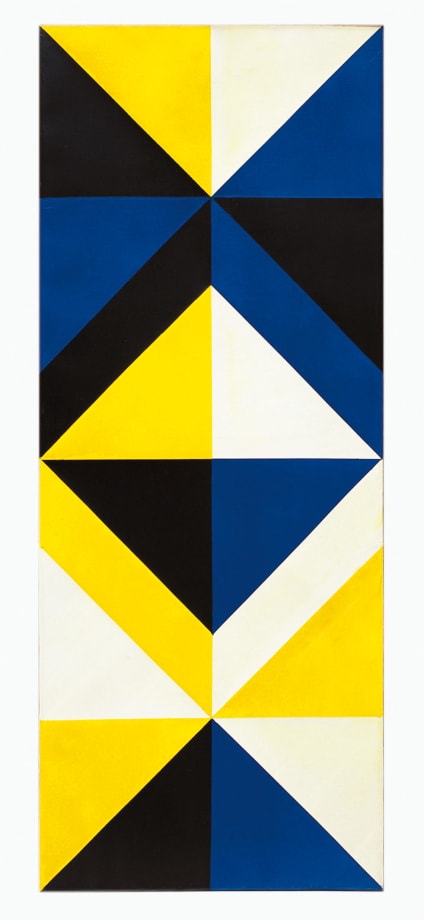Max Bill was born December 22, 1908 in Winterthur, Switzerland.
Between 1924 and 1927, he attended silversmith courses at the School of Applied Arts in Zurich. In 1925, he won the first prize in the competition for the manifest of the Suchard chocolate factory's jubilee. Between 1925 and 1929, Bill took trips to study in France and Italy. In 1927, he enrolled in various courses at Bauhaus College in Dessau, the upper institute of design. There Bill studied under renowned artists such as Vasily Kandinsky, Paul Klee and Walter Gropius.
In 1929, he moved to Zurich, where he worked as a painter, architect, and graphic artist. He carried out the graphic planning of some buildings along with representatives of the “Neue Bauen”. In 1932, Max Bill, Alois Cariget, Richard Paul Lohse, Herbert Matter, Heinrich Steiner, Hans Trommer and others came together in Zurich at the “Association of Independent Graphic Artist”, (later the Association of Swiss Graphic Artists). Bill met Hans Arp and Piet Mondrian. Between 1932 and 1936, Bill constructed and decorated the house/atelier of Zürich-Höngg.
From 1932 to 1936 he was associated with the Parisian group, “Abstraction-Création” with whom he exhibited for the first time in 1933. During the same year, he completed his first sculptures. In Paris, Bill met Georges Vantongerloo. In 1936, he exhibited in the Swiss Pavilion at the Triennial of Milan, and was given the Grand Prize. In 1937 he participated in the fifth CIAM (Congrès Internationaux d'Architecture Moderne), and during the same year he joined “Allianz” (Union of Swiss Modern Artists) who in 1941 created the publishing house of the same name. In 1944, Bill took part in the international exhibition Arte concreta at the Kunsthalle of Basel. During these years, Bill was very active, not only dedicating himself to art but also teaching and holding conferences, writing, and publishing articles, organizing exhibitions, and frequently traveling abroad. It was during these years that Bill asserted himself as a major figure of reference for contemporary art in Switzerland, taking on various institutional, national, and international appointments. In 1947, Bill was a member of the committee for the I.C.P. (Institut Für Progressive Kultur) foundation.
In 1949, Bill won the Kandinskij prize and became a member of U.A.M. (Union des Artistes Modernes) in Paris. During the 1950s and 1960s, Bill had the opportunity to meet many internationally famous architects with whom he started important collaborations and projects. In 1951, he was again given the Grand Prize at the Triennial of Milan and also given the Grand Prize for sculpture at the first Biennial of Art in Sao Paulo. Also in 1951, Bill was co-founder and architect of the Upper Institute of Design in Ulm, and from 1952 until 1956 he was provost of the Institute and director of the Architecture department and of the Form-Product department. From 1952 to 1962, he was a member of the central council of the S.W.B. (Association of Swiss Workers). In 1953, he became a member of the Biennial of San Paolo's jury.
Bill was a member of various association and councils during the 1950s and 1960s: the association of German workers, joined in 1956; the B.S.A. or Association of Swiss Workers in 1959; town council of Zurich from 1961-1968; Helvetian commission for art from 1961-1969; and National Swiss Council from 1967-1971. Between 1967 and 1968, he constructed and decorated the atelier of Zumikon. He taught environmental design from 1967 to 1974 at the Upper Institute of Figurative Arts of Hamburg. In 1968, he was given the Award for Art by the city of Zurich.
At the end of the 1960s, retrospective exhibitions were dedicated to Bill at museums in Bern, Hannover, Düsseldorf, The Hague, Zurich, Paris, and Grenoble. During the 1970s and the 1980s, Bill continued his theoretical activity and was frequently invited to hold conferences in schools and important athenaeums. Many of his sculptures can be found in public spaces in Europe, abroad, and in the collections of the world's most important museums. In 1972, he became a member of the Academy for the Arts in Berlin. In 1973, he was an outstanding member of the ”Accademia Fiamminga delle Scienze, Letteratura e Arti Decorative” and honorary council for UNESCO (the United Nations Educational, Scientific and Cultural Organization). In 1979, he was a member of the council of the Bauhaus Archival Association of Berlin.
Bill also received a variety of awards and honors: the city of Winterthur's Award, the Grand Cross of the German Federal Republic, an honorary diploma in engineering from the University of Stockholm, the “Imperial Ring” from the city of Goslar in 1982, the order of the Belgian Crown in 1982, named “Commandeur del'Ordre des Arts et Lettres de la France” in 1985, president of the Bauhaus archive of Berlin, the Frank. J. Malina Leonardo Prize from the Berkley International Society for the Arts, Sciences and Technology in 1987, the Marconi prize for art and science in Bologna in 1988, the Piepenbrock prize for sculpture in Osnabrück in 1989, Stockholm's Helmut Kraft prize for figurative arts in 1990, guest of honor at the XIX International Biennial of Graphics of Ljubljana in 1991, Imperial Award of Japan in 1993, named “Chevalier de la Légion d'Honner de la France” in 1993, the Grand Prix d'Honneur at the XIX International Biennial of Graphics of Ljubljana in 1993, and an honorary degree in Technical Sciences from the Helvetian Technical Institute of Zurich.
Max Bill died in Berlin in 1994.
